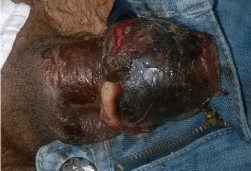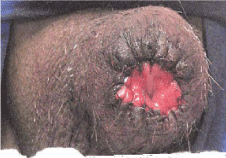Case Report
Distal Traumatic Penile Gangrene: A Rare Entity
Sudhir Kumar Jain, Dharmender Aggarwal*, Vishnuraja Rajendran and Ankit Jain
Department of Surgery, Maulana Azad Medical College, India
*Corresponding author: Dharmender Aggarwal, Department of Surgery, Maulana Azad Medical College, New Delhi – 110002, India
Published: 29 Nov, 2016
Cite this article as: Jain SK, Aggarwal D, Rajendran V, Jain
A. Distal Traumatic Penile Gangrene: A
Rare Entity. Ann Clin Case Rep. 2016;
1: 1192.
Abstract
Penile gangrene is a rare occurrence and have been associated with priapism, end stage renal disease, urethral obstruction and circumsicion but penile gangrene caused by blunt trauma has not been reported in the literature so far. We present case of a 50 year old male who presented with penile gangrene after a road traffic accident. Patient was managed by partial penectomy. Extensive investigations were done and other possible causes of penile gangrene were ruled out.
Keywords: Penile gangrene; Trauma; Penectomy
Introduction
Penile gangrene in general, is a rare occurrence but it is associated with significant morbidity and mortality [1]. Urethral stricture, impacted urethral calculus, circumsicion, priapism, diabetes mellitus and end stage renal disease have all been rarely attributed to cause penile gangrene [2,3], So far no case of penile gangrene has been reported caused by blunt trauma. Penile gangrene is rare because of multiple arteries supplying penis and good anastomosis among them. Fournier’s gangrene of the penis has been reported but it is associated with the involvement of skin and fascial planes only and involves scrotum invariably. In our case the gangrene involves a deeper tissue plane which differentiates it from fournier’s gangrene.
Case Presentation
A 50 year old male presented to surgery emergency with an alleged history of road traffic
accident, hit in groin by a scooter and fell afterwards and developed abrasions and contusive
injury by handlebar, 4 days back with complaints of blackening and swelling of penis which was
gradually progressive and associated with dull aching pain for past 3 days. There was no history
of urinary complaints or recent intercourse. Patient was not suffering from any chronic medical
illnesses.General physical examination was unremarkable with pulse rate 86/min and BP 116/78
mmhg. Patient was afebrile and had a slab applied over the left arm and forearm for the left radial
bone fractured during the accident. Slab was applied by a private practitioner in orthopaedics who
referred patient to surgery. On local examination gangrene of penis was present in the distal 4cm
with a clear line of demarcation from the healthy portion of penis.Penile arterial Doppler was done
which showed normal colour flow in the B/L cavernosal arteries in proximal healthy part, whereas
distal gangrenous portion could not be evaluated.
Patient was taken immediately for surgery.Intra operatively there was gangrene of the penis
involving skin, fascia and underlying corpora cavernosa and spongiosum with pus discharge in
anterior 2/3rd of the penis. Partial penectomy of the gangrenous portion with healthy margins was
done. Remaining stump was healthy with active bleeding. Post operative period was uneventful.
Biopsy report showed features of gangrene with viable periurethral residual margins and dilated
and congested vessels. No evidence of any embolism in arteries of gangrenous part. Post operatively
patient was evaluated extensively to rule out other causes for penile gangrene.
Blood investigations showed blood urea 16mg/dl, serum creatinine 0.6mg/dl, serum trigylcerides
150mg/dl and HDL 50mg/dl. The blood glucose was also within normal limits. ECG, Chest Xray and
echocardiography was performed which showed no abnormalities. Arterial Doppler was done for
aorta, B/L comman iliac, B/L external and internal iliac arteries and showed normal flow without
any plaques or source of embolism. Well informed and written consent was obtained from patient
while keeping the identification of patient confidential.
Figure 1
Figure 2
Discussion
Penis is formed by erectile tissue in the form of corpora cavernosa and corpora cavernosa.
Urethra passes through corpora spongiosum. Corpora cavernosa and spongiosum arecovered by tunica albuginea, buck’s fascia, dartos fascia and skin from inside
outwards. Penis is supplied by branches of internal pudendal artery
[4]. Bulbo-cavernousartery passes in corpus spongiosum and supply
urethra and bulbo-urethral glands. Deep/cavernous arteries passes
into corpus cavernosum and dorsal artery of penis in dorsum of penis
deeper to veins. These 3 planes are complementary and supplemented
by planes immediately above it [4]. Due to this peculiar arrangements,
gangrene of penis is very rare entity.
Gangrene of the penis may be dry or infective and the causative
factors may be infective or vascular [5]. Among infective causes,
mostly the source of infection can be identified in form of urethral
stricture and perianal abscess, fissures, fistula and instrumentation
[3]. Infective gangrene is usually associated with signs of sepsis.Dry
gangrene, on the other hand is classically vascular in origin. The most
common cause for ischaemic penile gangrene is diabetes mellitus with
end stage renal disease leading to secondary hyperparathyroidism
and subsequent calciphylaxis of penile arteries [3]. Other causes for
dry gangrene include tourniquet syndrome, priapism and venous
thromboembolism causing venous engorgement and swelling of
penis which further leads to arterial insufficiency leading to dry
gangrene. Case reports of penile gangrene after heroine injection has been reported, in which the injection into the femoral vessels causes
arterial embolization of particulate matter into microcirculation of
the genitalia causing arterial thrombosis [6]. Similarly there is case
report of isolated gangrene of the corpus spongiosum for idiopathic
origin [7]. Penile gangrene due to fournier’s infection has been
reported but it is limited to skin and fascial planes only and does not
involve corpora tissues.
A possibility of coitus related ring entrapment gangrene was
also considered as a cause for this gangrene but ring entrapment
is generally seen at base of penis for prolongation of erection and
mid shaft is not usual site for this type of injury. Further, almost all
ring entrapment gangrene shows an impression of ring in proximal
healthy part, which was not present in our case. Patient was not
having any psychiatric illness and was also accompanied by his wife,
who also confirmed the history.
Our patient presented with penile gangrene without sepsis
indicating it as a dry gangrene. Patient was not a diabetic and his renal
function was also normal. There was no history of priapism, any drug
intake or any drug abuse. The only associated factor was of trauma 4
days back.
Our hypothesis is blunt trauma might have caused severe
vasospasm of all penile arteries resulting in gangrene of penis, as all
other causes were ruled out by thorough investigations.
Conclusion
Trauma as a cause for penile gangrene needs to be evaluated further and more evidence will be needed for establishing it a cause for same.
References
- Spirnak JP, Resnick MI, Hampel N, Persky L. Fournier`s gangrene: Report of 20 patients. J Urol. 1984; 131: 289-291.
- Ntia IO, Mungadi IA. The pattern of penile gangrene in Sokoto, Nigeria. African J Urol. 2007; 13: 256-261.
- Singh V, Sinhaa RJ, Sankwar SN. Penile gangrene: A devastating and lethal entity. Saudi J Kidney Dis Transpl. 2011; 22: 359-361.
- Juskiewenski J, Vaysse PH, Moscovici J, Hammoudi S, Bouissou E. A study of the arterial blood supply to the penis. Anatomia Clinica. 1982; 4: 101- 107.
- Stein M, Anderson C, Ricciardi R, Chamberlin JW, Lerner SE, Glicklich D. Penile gangrene associated with chronic renal failure: report of 7 cases and review of the literature. J Urol. 1994; 152: 2014-2016.
- Somers WJ, Lowe FC. Localized gangrene of the scrotum and penis: A complication of heroin injection into the femoral vessels. J Urol. 1986; 136: 111-113.
- Kharbach Y, Tenkorang S, Bouchikhi A, Mellas S, Ammari JE, Tazi MF, et al. Elective gangrene of the corpus spongiosum of idiopathic origin: A case report. Can Urol Assoc J. 2014; 8: 934-937.


